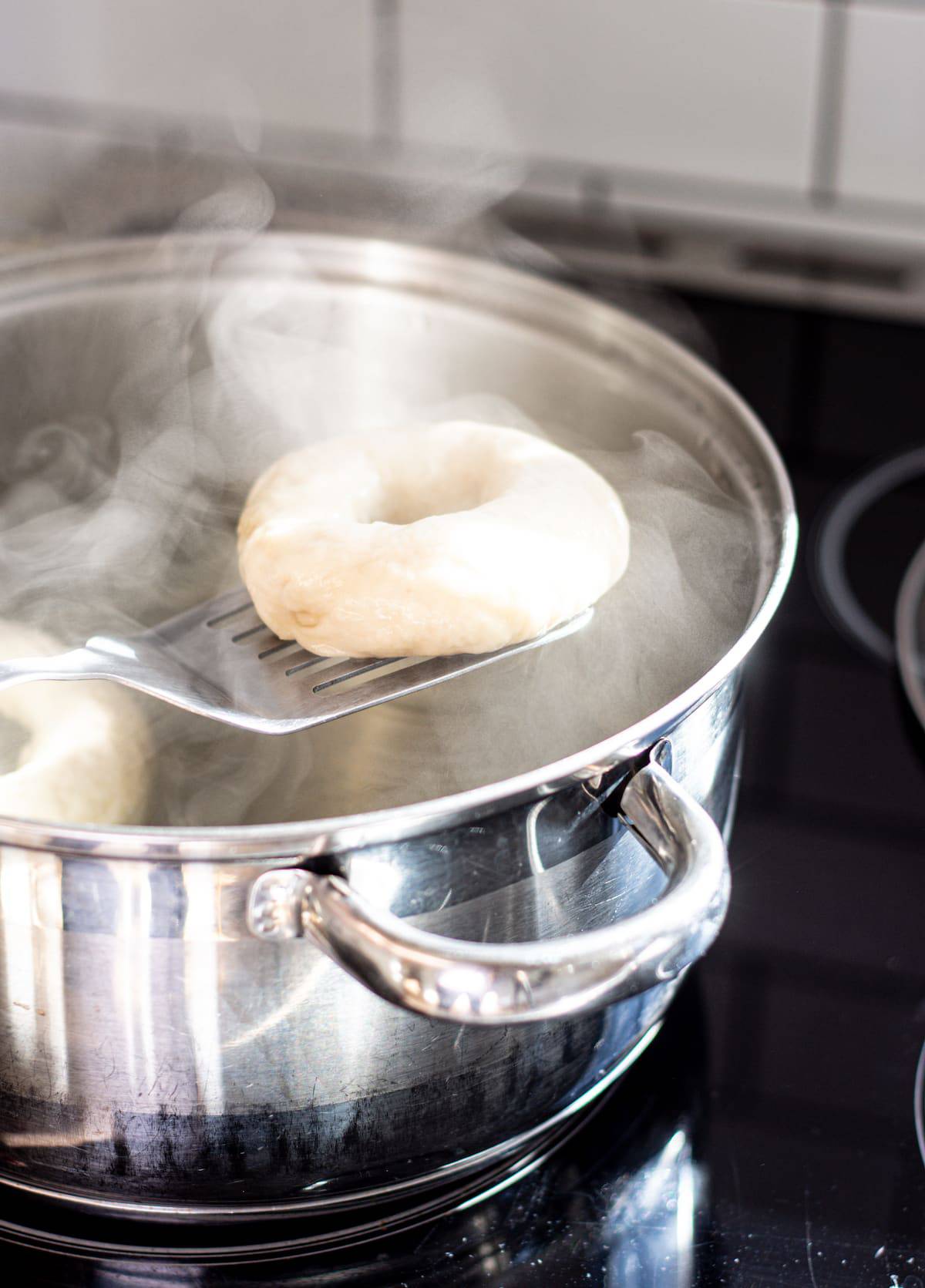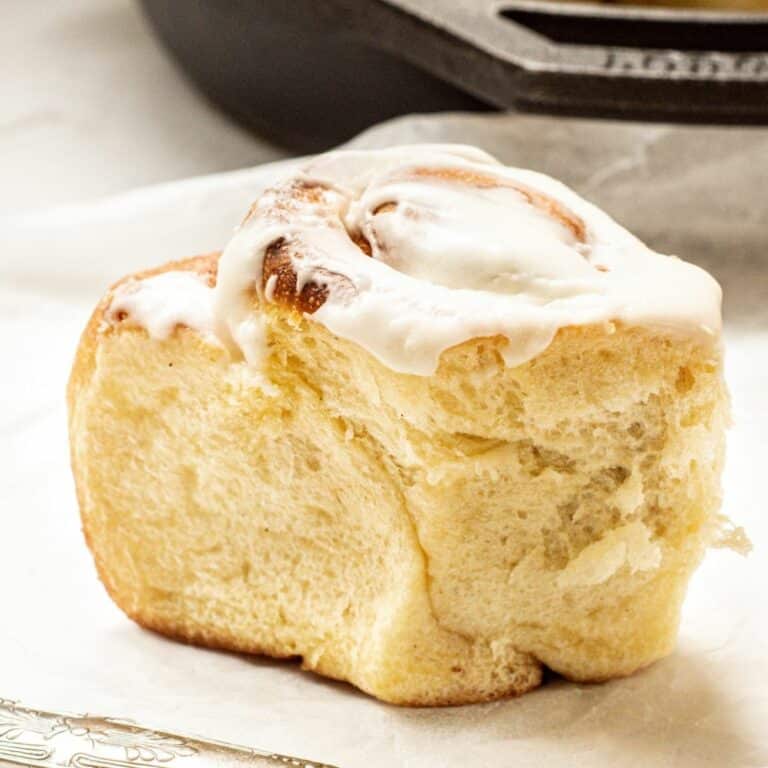Easy Overnight Bagel Recipe
Thick with the right amount of toothsome chew, this overnight bagel recipe makes the best homemade bagels.
Reader Lauren says “This is the best bagel I have ever eaten!!!!”

Fresh, homemade bagels are something special. They’re slightly dense, with a chewy crumb and a shiny exterior. They’re great fresh or toasted, and make the best vessel for cream cheese, salmon, and avocado.
They use a thick, stiff dough so it’s easy to knead by hand, and it’s fun to shape, poach and bake them! For the best flavor, make overnight bagels and let the dough chill in the fridge overnight. However, if you’re in more of a hurry, they can be made on the same day, too.
The ingredients
These chewy bagels use a very simple dough made with ingredients readily found in the pantry. Find the amounts in the recipe card at the bottom of this post. You will need:
- Bread flour or strong all-purpose flour – Bagels should have a decent amount of toothsome chew to them. Use a high-gluten bread flour for the classic bagel chew – flour with a protein level between 11-13%.
- Yeast. Use instant or active dry yeast in this recipe. Whichever one you use, it needs to be viable. Usually, the instant yeast sachets are pretty foolproof, but sometimes active dried yeast can lose viability.
- Lukewarm water
- Barley malt syrup or soft brown sugar. Barley malt syrup is traditional and preferable, but if you don’t have it you can substitute it with brown sugar.
- Salt – For flavor.
- Honey (for poaching)
- Sesame seeds, poppy seeds or bagel seasoning for toppings
Dough hydration
The dough in this bagel recipe is quite low hydration. This means there isn’t a lot of liquid compared to flour. It makes a thick dough that is easy enough to work with as it won’t stick to your hands, but it requires a little elbow grease to knead.
Put a few songs on while doing so, and time will pass quickly! It’s a dough that is best worked by hand, as it can be a bit thick for some stand mixers. If you do choose to use a stand mixer, use a dough hook attachment at low speed.
Method
- In a large bowl, combine the water, yeast, and brown sugar and stir it together. Leave it to sit for 5 minutes until foamy. Add the flour and salt and use a fork to combine everything into a rough dough.

- Switch to using your hands and push the dough together into a stiff, rough ball. Tip it into a clean bench. Knead the dough for around 10 minutes to develop the gluten.
- If you get tired, take a break and let the dough sit, then come back to it after a few minutes.

- Once smooth and strong, place it in a greased bowl.
- You have the choice to give the dough an overnight rise in the fridge and shape and bake them the following day or make and bake them on the same day.
Overnight bagel recipe
An overnight slow rise (or even longer) gives the best texture and flavor and gives some flexibility when you want to bake them. Place the dough in an oiled bowl or container and cover with an airtight lid or plastic wrap. Let the dough rest in the fridge for up to 24 hours.
- Cover the dough with a damp tea towel or plastic wrap and refrigerate for 8-24 hours.
Shaping
- The following day, pull the dough ball out of the bowl onto a lightly floured work surface. Cut the dough into eight equal pieces (a scale works well to ensure even bagels) and shape each piece into a ball. Let these dough balls rest for 10 minutes.
The Poke Method – using your thumbs and index fingers, push a hole into the middle of the dough ball, then roll the dough ball around your fingers in a circular motion to widen the hole.

Using your thumbs, push a hole into the middle of the dough ball, then roll the dough ball around your fingers in a circular motion to widen the hole.

Aim for a large hole as it will shrink back in size once it sits.
The Roll Method – Roll the dough ball into a rope about 8-10 inches long, slightly tapering the rope at the ends. Wrap the rope around your hands with the ends overlapping by about an inch. Seal the ends together by rolling the overlap on the counter.
- Place the shaped bagels on a prepared sheet pan lined with parchment paper and let them puff out a bit, for around 20-30 minutes while the oven preheats and a pot of water is brought to a boil.
Poaching bagels


- Bring a large pot of water to a boil and add in a tablespoon of honey. Keep the water at a rolling boil and poach 2-3 bagels at a time.
- They don’t need a long boiling time, only 30 seconds on each side. After poaching, remove the boiled bagels with a slotted spoon or spatula and place them on a baking tray and sprinkle with seeds or seasoning (if using.)
- Bake the bagels until deep golden brown. As the bagels come from the oven they will be very hard. Don’t worry, they will soften as they cool. Place them on a wire rack to cool down.
Serving and storing
Bagels are delicious when served on the day they are made. Leftover bagels can be stored, and covered at room temperature for up to 3 days.
Bagels freeze very well too which will prolong their life. They can be frozen for up to 3 months. Thaw frozen bagels at room temperature, in a toaster, microwave, or low-temperature oven.

FAQS
If you make the initial holes too small when shaping the bagels, the dough will shrink back too much and you’ll lose the bagel holes.
If the bagels were left to rise too long they may overproof and lose their structure, resulting in flat and wrinkly bagels.
Lack of gluten development (which could be a lack of kneading or a weak flour), can result in a rougher bagel crust. If your crust is wrinkly it can be a sign of over-proofing.
This could be due to expired yeast or lack of proofing.
Spices can be added at the same time as the other ingredients. Larger additions such as dried fruits, nuts or seeds can be added at the end of the kneading period.
Between 8-24 hours.
Use high-gluten flour for the classic bagel chew – flour with a protein level between 11-13%. This is best done with bread flour.
Related recipes
Try these blueberry bagels, sourdough bagels or cinnamon raisin bagels next!
For more bread ideas, you could look to bake this easy focaccia bread recipe or this buttery homemade brioche bread!

Easy Overnight Bagels
Ingredients
- 250 g lukewarm water
- 1 1/2 teaspoon instant yeast or active dried yeast
- 2 Tablespoon barley malt syrup or soft brown sugar
- 440 g bread flour with a protein level of at least 11%
- 1 1/2 teaspoon salt
Poaching
- 2 liters water
- 1 Tablespoon barley malt syrup, brown sugar or honey
- Poppy seeds or sesame seeds for sprinkling
Instructions
- In a large bowl, combine the water, yeast, and malt syrup or sugar and stir it together. Leave it to sit for 5 minutes until foamy.
- Add the flour and salt and use a fork to combine everything into a rough dough. Switch to using your hands and push the dough together into a stiff, rough ball. Tip it into a clean bench.
- Knead the dough for around 10 minutes to develop the gluten. If you get tired, take a break and let the dough sit, then return to it after a few minutes.
- Once kneaded, place it in a greased bowl. Cover the dough with a damp tea towel or plastic wrap and refrigerate for 8-24 hours.
Shaping the bagels
- Remove the dough from the fridge and pull it from the bowl onto a clean bench. Cut the dough into 8 even pieces and shape each piece into a ball. Let the dough balls rest for 10 minutes.
- Using your thumbs, push a hole into the middle of the dough ball, then roll the dough ball around your fingers to widen the hole. Aim for a large hole as it will shrink back in size once it sits.
- Place the shaped bagels on parchment paper and let them rise for around 20-30 minutes until puffed. Preheat the oven to 425°F/220°C.
Poaching
- Bring 2 liters of water to a boil and add in the honey. Keep the water at a rolling boil and drop in 2-3 bagels at a time. Poach each bagel for 1 minute (30 seconds on each side.)
- Use a slotted spatula to lift the bagels out and let them drain for a few seconds. Place them on a parchment paper-lined baking tray and sprinkle over any seeds for toppings whilst they are still sticky from the water.
Baking
- Place the poached bagels in the oven and let them bake for 20-22 minutes until deep golden brown. If they are baking unevenly or your oven has hot spots, turn the oven tray around after 15 minutes of baking.
- Remove the baked bagels from the oven and let them cool before slicing.






This is the best batch of bagels I’ve ever made!! Such an easy to follow recipe and love the option of refrigerating for a period or baking same day!
This is the best bagel I have ever eaten!!!!
Super easy and flexible dough and very tasty